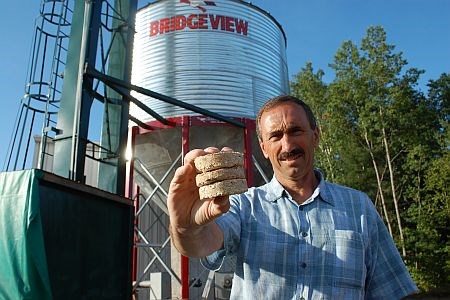Going down the wood pellet path has caused some anxious moments for the folks at Powassan's Quality Hardwoods.
When the price of heating oil, used to fire their 10 drying kilns, peaked at more than a dollar per litre last year, owner Paul Brooks and operations manager Pete Van Amelsfoort decided to take a bold step.
They invested $1 million in a heating system to burn wood pellets by installing two Decker boilers, distribution piping with a 60-tonne silo and a grain elevator-like system of conveyors and buckets.
For a few months, everything was going well. The price of pellets was good at $120 per tonne. Compared to heating oil, the pellets burned so efficiently it appeared using them would save the company $100,000 to $150,000 a year.
About every two weeks, a transport truck loaded with pellets arrived from their supplier in southwestern Ontario.
Then their supplier went bankrupt, forcing Van Amelsfoort to scout for a new source, even as far away as Michigan.
But the price to ship pellets in bulk was going up and the price of heating oil was coming back down. It wasn't economically to keep burning pellets. Luckily for the company, the oil furnace was still kept as a back-up. Van Amelsfoort and his staff decided to switch back.
“The best (wood pellet) price was such that it couldn't beat oil,” said Van Amelsfoort.
But the company isn't gun-shy about staying on the biomass trail. During that short stretch of four months, they realized savings of about 20 to 30 cents per litre compared to heating oil.
In recent weeks, the company is back experimenting with puck-shaped wood briquettes for their boilers. Made of compressed poplar, oak, and maple, they are shipped north from a Toronto supplier.
“It's the same process used to make firewood logs,” said Van Amelsfoort.
Though it forced the company to make expensive modifications to their storage unit to allow the larger briquettes to flow freely, “we're going to make it work,” he said.
Burning renewable fuels dovetails nicely with the company's FSC-certified processes – considered the environmental gold standard for sustainable forestry production – and enables them to trade carbon credits.
Quality Hardwood's wood pellet predicament shines a spotlight on a great unanswered question about the sustainability of Ontario's waste wood fibre supply when the Ontario government finally rolls out the details of its biomass procurement strategy later this year or early 2010.
Ontario Power Generation (OPG) will require a huge amount to make good on the McGuinty government's promise to be off coal by 2014.
The hard numbers of how much biomass is out there, and how it will be shared by big and small industry and community groups, and also the price to harvest and transport it, should play big factors in the future use of this green fuel.
While it's easy to get caught up in the day-to-day operational challenges, Van Amelsfoort prefer to look at the big picture.
Powassan sits in middle of a vast breadbasket of fibre being called a Biomass Belt by Nipissing University researchers. It's an area that encompasses Sudbury, West Nipissing, Parry Sound, Huntsville and Gravenhurst.
Van Amelsfoort said there are thousands of hectares of marginal land near the mill -- both private and Crown -- that can be converted to biomass fields. The area is stocked with low-end of the fibre supply that can be fed into co-generation plants or kilns to produce heat that can be used to dry high-end quality fibre.
It remains to be seen how it will all come together to ensure Ontario's quantity of biomass is evenly shared by Ontario Power Generation, pulp and paper producers and the small forestry players.
“It's all infrastructure, logistics and politics,” said Van Amelsfoort.
Hopefully the cloudy biomass picture will become clearer after a two-day conference at North Bay's Nipissing University this fall.
The school's new Biomass Innovation Centre is hosting the event entitled, Harness Biomass: From the Forest to the Marketplace takes place in North Bay, Oct. 22-23.
One of the conference's objectives is to encourage development of a clean tech biomass cluster for heating and energy.
The biomass centre, established last spring, is intended to serve as a catalyst to expand the knowledge base and support the development of clean and green technology in the region. The on-campus expertise draws from the business, economics and environmental faculty.
The conference will cover topics on Ontario's biomass inventory, opportunities and challenges for harvesters and First Nations, the European and U.S. experience, addressing logistics issues, wood characteristics, and a slew of other talks on market opportunities, along with technical and regulatory hurdles.
North American and international experts in forest management, harvesting, logistics, industry use, academic research and government policymaking will be making presentations, including OPG's Chris Young, vice-president of Fossil Projects, who will update the publicly-owned utility's biomass procurement process.
“We'll have a sense of where biomass stands competitively,” said John Nadeau, a Nipissing marketing professor, who will present his findings on what potential biomass users are saying.
A former market analyst for Tembec, Nadeau has been interviewing “large regional organizations” who are potentially big buyers of biomass and is recording their perceived strengths and barriers of using wood fibre for heating and energy. “There is huge industry from industry players.”
Though reluctant to disclose his findings, “anecdotally there is still some concern about sustainability of supply.”
However there are encouraging signs for this emerging industry with a former Tembec sawmill in Mattawa being eyeballed by potential private suitors for a wood pelletizing operation.
“It's creating a buzz and the opportunity is now,” said Nadeau
This conference falls on the heels of an inaugural biomass networking event held last winter in North Bay. This upcoming event will “pull back another layer of the onion to provide a better picture of what to look at.”
For details on conference registration, visit www.nipissingu.ca/biomass/registration.asp .




